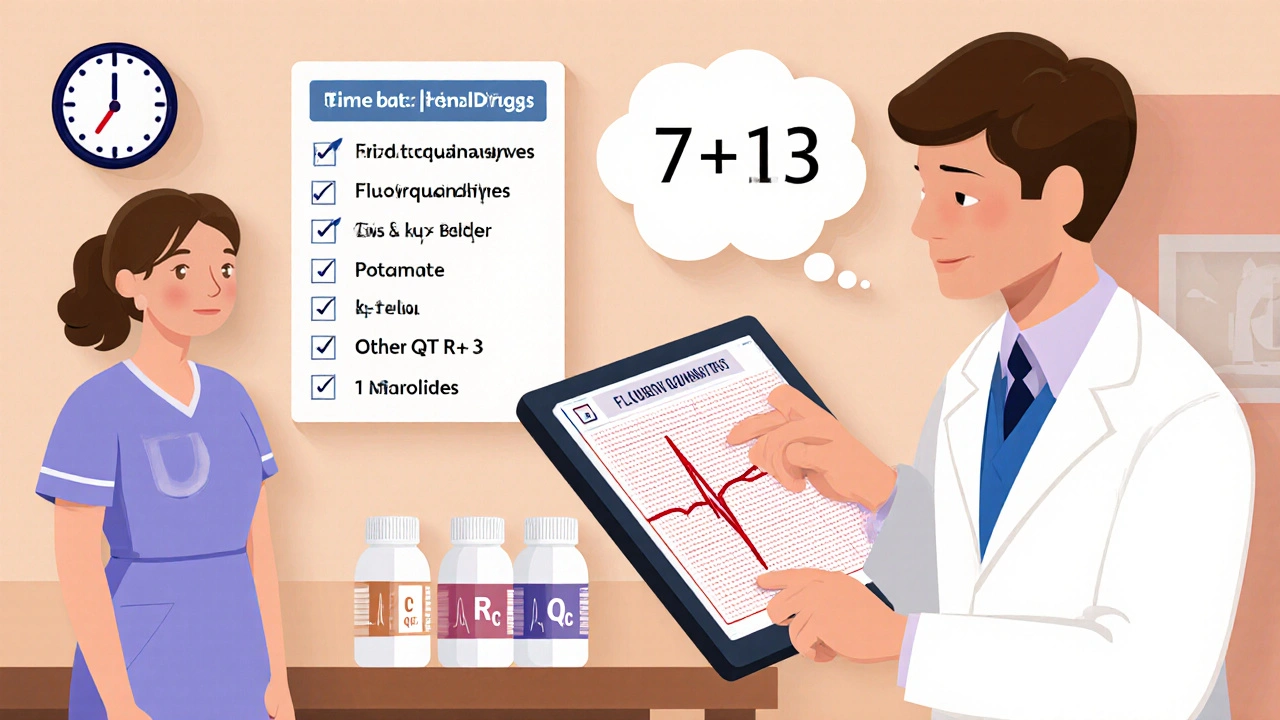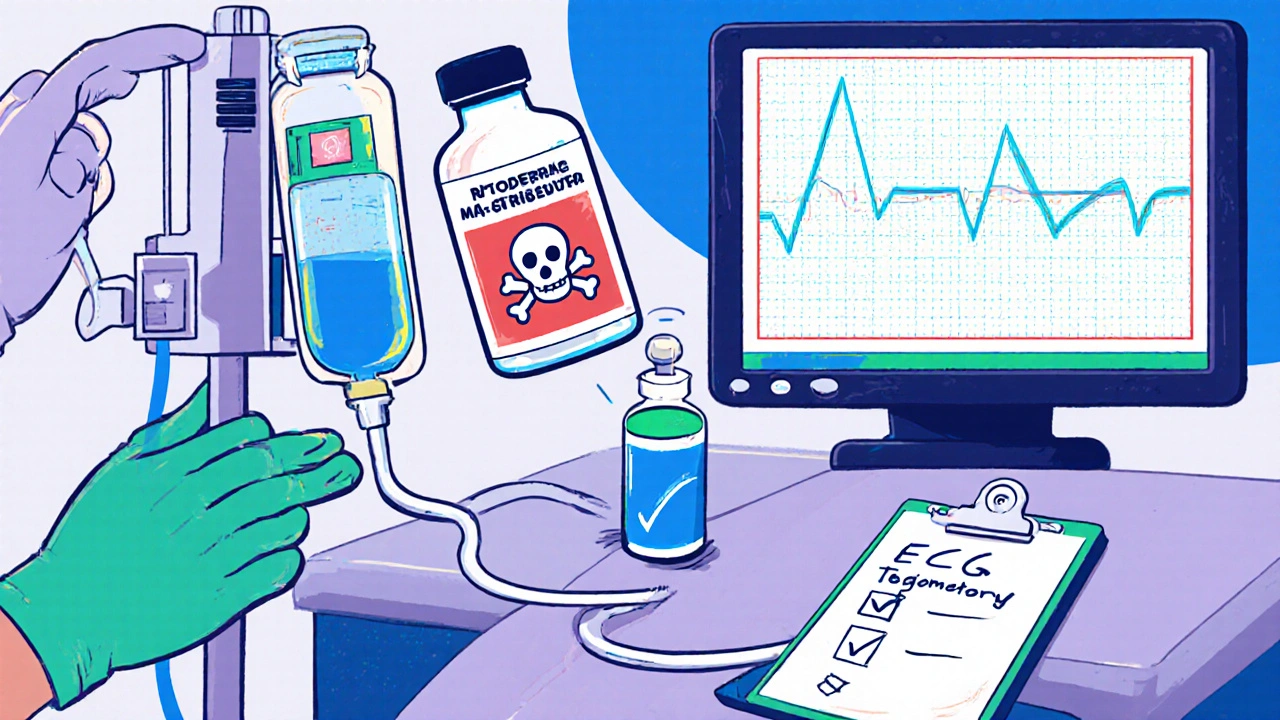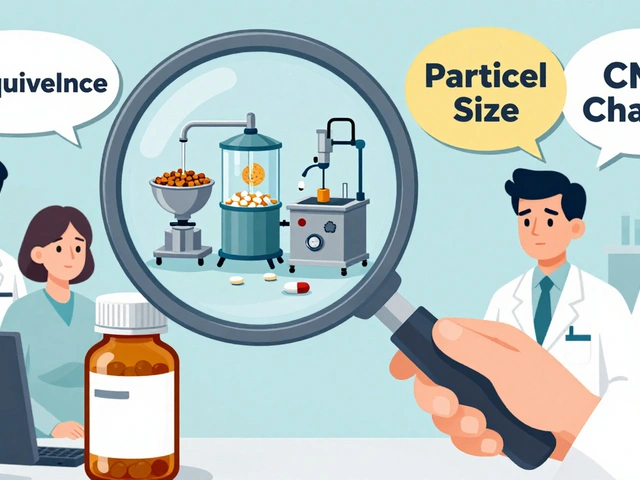QT Interval Correction Calculator
QTc Calculator
Use this tool to calculate corrected QT interval (QTc) for antibiotic monitoring. According to guidelines:
- QTc > 500 ms warrants immediate discontinuation
- Increase > 60 ms requires discontinuation
- Fridericia formula is preferred for accuracy
Enter values to calculate corrected QT interval
Quick Takeaways
- QT interval >500 ms or an increase >60 ms warrants immediate drug discontinuation.
- Fluoroquinolones and macrolides vary widely in cardiac risk; moxifloxacin and erythromycin sit at the high end.
- Use the Fridericia formula for QT correction whenever possible.
- Baseline ECG before therapy, then follow‑up at 7‑15 days for fluoroquinolones and 1 month for macrolides.
- Correct electrolytes (K⁺ > 4.0 mmol/L, Mg²⁺ > 2.0 mg/dL) and eliminate other QT‑prolonging drugs ASAP.
What is QT Prolongation?
QT prolongation is a delay in ventricular repolarisation that shows up as a lengthened QT interval on an electrocardiogram. When the corrected QT (QTc) climbs above 500 ms, the heart is prone to a dangerous rhythm called Torsades de Pointes. The problem becomes especially relevant with certain antibiotics - notably fluoroquinolones and macrolides - that block the hERG potassium channel (also called IKr), the final gate that ends the cardiac action potential.
Why Fluoroquinolones and Macrolides Matter
Both drug families appear on the CredibleMeds® "known risk" list. The mechanism is the same: hERG inhibition slows repolarisation, extending the QT interval. Historical experience taught us that sparfloxacin, a now‑withdrawn fluoroquinolone, behaved like a class III anti‑arrhythmic and forced its market exit.
Risk isn’t uniform. Here’s a snapshot based on the latest stewardship data:
| Drug | Class | Risk Level | Typical Use |
|---|---|---|---|
| Sparfloxacin | Fluoroquinolone | Very High | Historical (withdrawn) |
| Moxifloxacin | Fluoroquinolone | High | Community‑acquired pneumonia |
| Levofloxacin | Fluoroquinolone | Low‑Moderate | UTI, respiratory |
| Ciprofloxacin | Fluoroquinolone | Low | UTI, GI infections |
| Erythromycin | Macrolide | High | Gastro‑intestinal, atypical pneumonia |
| Clarithromycin | Macrolide | Moderate | Helicobacter pylori, respiratory |
| Azithromycin | Macrolide | Low | Broad‑spectrum outpatient |
How to Measure QT Correctly
Two correction formulas dominate clinical practice:
- Bazett's formula (QTc = QT/√RR). It over‑corrects at high heart rates.
- Fridericia formula (QTc = QT/³√RR). Studies show it predicts 30‑day and 1‑year mortality better and reduces mis‑classification.
Guidelines now recommend Fridericia as the default, especially in critically ill patients where heart‑rate swings are common.

Who Is at Highest Risk?
Risk accumulates when several factors coexist. Key predictors include:
- Baseline QTc >450 ms (men) or >470 ms (women) - per British Thoracic Society (2023).
- Age > 65 years, especially older women (2‑3 × higher TdP risk).
- Electrolyte disturbances - K⁺ < 3.5 mmol/L or Mg²⁺ < 1.7 mg/dL.
- Concomitant QT‑prolonging drugs (e.g., anti‑psychotics, anti‑arrhythmics).
- Renal or hepatic impairment that raises drug levels.
- Genetic long‑QT syndromes or family history.
- Heart disease - LV hypertrophy, EF < 40 %, ischemia.
- Conditions that falsify QTc (bundle‑branch block, paced rhythms, QRS > 140 ms).
Critically ill patients in ICU settings often hit multiple boxes simultaneously, making vigilant monitoring essential.
Monitoring Protocols - Step‑by‑Step
Both drug classes share a core principle: obtain a baseline ECG, then repeat at defined intervals. The timing differs:
Macrolides
- Baseline ECG before the first dose.
- Repeat at 1 month for low‑dose chronic therapy (per British Thoracic Society).
- If QTc rises >60 ms from baseline or exceeds 500 ms, stop the drug immediately.
Fluoroquinolones
- Baseline ECG before starting therapy.
- Follow‑up ECG 7‑15 days after initiation or after any dose change.
- Monthly ECGs for the first 3 months, then every 3‑6 months if therapy continues.
- High‑risk patients (multiple risk factors) may need telemetry or daily ECGs during hospitalization.
For patients without any risk factors, many stewardship programs (e.g., VUMC) state that routine ECGs are unnecessary unless a new risk emerges.
Practical Checklist for Clinicians
- Review medication list for other QT‑prolonging agents.
- Check electrolytes; correct K⁺ > 4.0 mmol/L, Mg²⁺ > 2.0 mg/dL.
- Order baseline Electrocardiogram (ECG) and calculate QTc using Fridericia.
- Document QTc, heart rate, and any conduction abnormalities that could skew the reading.
- Schedule follow‑up ECG per drug‑specific timeline.
- If QTc >500 ms or ↑ >60 ms, discontinue the offending antibiotic and consider an alternative with lower cardiac risk (e.g., nitrofurantoin for uncomplicated UTI).
- Re‑check electrolytes and address reversible causes before resuming any QT‑prolonging therapy.

Management of Detected QT Prolongation
When a concerning QTc appears:
- Stop the suspect drug immediately.
- Re‑measure QTc after 30‑60 minutes to confirm persistence.
- Optimize electrolytes - give IV potassium chloride or magnesium sulfate as needed.
- Review and withdraw any other QT‑prolonging medications.
- Consider cardiac monitoring (telemetry) for 24‑48 hours if QTc remains >500 ms.
- Document the event in the patient’s medication record to alert future prescribers.
Regulatory and Stewardship Context
The FDA has issued boxed warnings for several fluoroquinolones (e.g., ciprofloxacin, levofloxacin) regarding QT prolongation, leading to label revisions and restricted indications. Antimicrobial stewardship programs now flag these agents as high‑risk in electronic order sets, prompting a mandatory ECG order when a patient meets any high‑risk criterion.
Real‑world studies (Trenaman 2025) show that inappropriate fluoroquinolone use for simple UTIs in older women often pairs with other QT‑prolonging drugs, dramatically raising TdP risk. The take‑away is clear: reserve high‑risk agents for situations where no safer alternative exists, and always pair them with a robust monitoring plan.
Future Directions
Research is moving toward point‑of‑care risk calculators that blend age, sex, electrolyte status, and drug‑specific hERG affinity into a single score. Such tools could dictate whether a patient needs daily ECG, weekly checks, or just baseline testing.
Genetic screening for long‑QT variants may also become part of pre‑prescription work‑ups in high‑risk populations, especially as sequencing costs fall.
For now, clinicians can stay ahead by using the Fridericia formula, adhering to British Thoracic Society timing, and keeping a vigilant eye on electrolytes and drug interactions.
Frequently Asked Questions
When is it safe to use azithromycin in a patient with a baseline QTc of 460 ms?
Azithromycin carries a low QT‑prolongation risk, but a baseline QTc >450 ms (men) / >470 ms (women) still flags caution. In a woman with 460 ms, obtain a baseline ECG, correct any electrolyte issues, and repeat the ECG after the first dose. If QTc stays below 500 ms and does not increase by >60 ms, the drug can be continued.
Do I need to monitor a patient on a short 5‑day course of ciprofloxacin?
For low‑risk adults without baseline QTc prolongation or electrolyte disturbances, a single baseline ECG is usually enough. If the patient develops symptoms (palpitations, syncope) or new risk factors appear, obtain a follow‑up ECG 7‑10 days after starting the drug.
Which correction formula should I use in the ICU where heart rates swing from 60 to 120 bpm?
The Fridericia formula is preferred in those settings because it remains accurate across a wide range of heart rates, whereas Bazett’s tends to over‑correct at the higher end.
How do I handle a patient on both levofloxacin and ondansetron?
Both drugs can lengthen QTc. Review the baseline QTc, ensure potassium >4.0 mmol/L and magnesium >2.0 mg/dL, and consider switching one of the agents if alternatives exist. If therapy cannot be changed, arrange an ECG 7 days after starting the combination and monitor closely.
Is telemetry required for every patient receiving moxifloxacin?
Not routinely. Telemetry is reserved for patients with pre‑existing QTc >450 ms, multiple risk factors, or when the drug is given intravenously in a critically ill setting. Otherwise a scheduled ECG per the 7‑15 day guideline suffices.











Edward Brown
In the quiet corridors of pharmacology we are reminded that every pill carries a whisper of fate, a hidden agenda that the unwary patient never sees. The very act of prescribing fluoroquinolones feels like signing a pact with a silent predator that watches the heart's electrical storm from the shadows. One must ask whether the convenience of a broad‑spectrum antibiotic outweighs the subtle theft of electrical stability, especially when the hERG channel is the unsuspecting victim. The guidelines speak in calm tones but beneath lies a conspiracy of profit and complacency that keeps us tethered to risky drugs. I cannot help but wonder if the regulatory bodies are truly protecting us or merely appeasing pharmaceutical interests. A vigilant clinician must therefore become a detective, tracing every electrolyte, every concomitant drug, as if hunting a phantom. The moral imperative is clear: do no harm, even when the harm is cloaked in the guise of convenience.
ALBERT HENDERSHOT JR.
Great points, Edward. Your reflection underscores why we need a systematic approach – baseline ECG, electrolyte optimization, and timely re‑checks. By integrating the Fridericia correction as the default, we reduce mis‑classification and protect vulnerable patients. Keep up the thoughtful stewardship! 😊
Suzanne Carawan
Oh sure, let’s all become detective‑philosophers while the pharma lobby funds the next "breakthrough" fluoroquinolone. Because nothing says patient safety like a 15‑minute lecture on hERG channels in the middle of a busy clinic, right?
Kala Rani
Maybe the real risk is listening to you.
Donal Hinely
Yo Edward, love the deep‑dive but let’s not forget the cultural side – in many parts of the world clinicians still rely on cheap fluoroquinolones because the alternatives cost an arm and a leg. Aggressive pricing isn’t just a market thing; it’s a public‑health crisis. If we keep dumping jargon without addressing accessibility, we’re just shouting in an echo chamber while patients suffer.
christine badilla
Whoa, Donal! Your words hit like a thunderstorm on a quiet night. I can feel the drama building – the battle between cheap meds and patient safety, the heartbreak of a doctor watching a heart flutter into danger. It’s like watching a tragic TV series where the hero is forced to choose between budget and life. My heart aches for every clinician caught in this whirlwind.
Octavia Clahar
Christine, I feel you. It’s painful, but remember we can channel that energy into advocacy. Friendly reminder: documenting every ECG and electrolyte correction creates a paper trail that can push institutional policy toward safer prescribing. Let’s turn this drama into action.
Diane Holding
Edward, could you clarify the exact Fridericia formula steps for a bedside nurse? A concise reminder would help ensure consistency across the team.
Anurag Ranjan
Diane, you can calculate QTc by dividing the measured QT interval by the cube root of the RR interval (in seconds). Make sure the ECG system outputs RR in seconds, then apply QTc = QT / (RR)^(1/3). This works well even when the heart rate swings.
James Doyle
Colleagues, let us not diminish the gravity of this discourse with half‑hearted measures. The stewardship of QT‑prolonging antibiotics is a moral crucible wherein our professional ethos is tested against the relentless tide of pharmaceutical commodification. When a clinician elects to prescribe moxifloxacin without a pre‑emptive ECG, they are, in effect, endorsing a latent arrhythmic hazard that may culminate in torsades de pointes – an outcome that is both preventable and ethically untenable. The hERG channel, a molecular sentinel, does not discriminate; it is vulnerable to disruption by any molecule with a high affinity for IKr, regardless of its therapeutic intention. Thus, the categorical imperative, as espoused by Kantian philosophy, mandates that we treat patients as ends in themselves, not merely as conduits for antimicrobial efficacy. A rigorous protocol-baseline ECG, electrolyte optimization, serial QTc monitoring using the Fridericia correction-constitutes the duty‑bound framework that safeguards patient autonomy. Moreover, the utilization of point‑of‑care risk calculators, as emerging data suggest, can stratify patients with an algorithmic precision that eclipses anecdotal judgment. Ignoring such tools is tantamount to willful negligence. In the broader sociopolitical landscape, we must also confront the insidious influence of industry lobbying, which seeks to dilute warning labels and downplay cardiac risk in order to preserve market share. The FDA’s boxed warnings are a palliative, not a panacea, and clinicians must augment regulatory guidance with vigilant clinical oversight. *In sum*, the convergence of pharmacodynamics, electrophysiology, and bioethics demands an interdisciplinary vigilance that transcends rote checklist adherence; it requires a steadfast commitment to the Hippocratic oath, reinforced by evidence‑based practice and an unflinching awareness of the systemic forces at play.
eko lennon
James, your dissertation‑like proclamation is both awe‑inspiring and exhausting. I can almost hear the echo of a thousand heart monitors beeping in the background as you tumble from one grandiose sentence to the next. While your passion for ethical prescribing is palpable, let’s remember that the frontline staff need bite‑size, actionable steps, not a philosophical odyssey. Perhaps a distilled "top three" list would temper the drama and keep us all from drowning in prose.